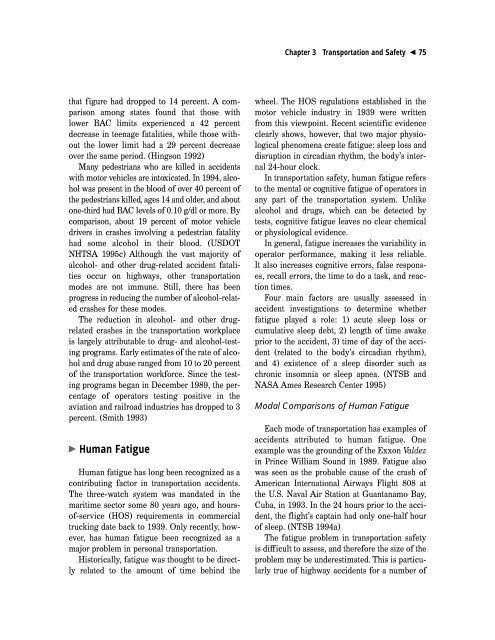table of contents - Research and Innovative Technology ...
table of contents - Research and Innovative Technology ...
table of contents - Research and Innovative Technology ...
You also want an ePaper? Increase the reach of your titles
YUMPU automatically turns print PDFs into web optimized ePapers that Google loves.
that figure had dropped to 14 percent. A comparison<br />
among states found that those with<br />
lower BAC limits experienced a 42 percent<br />
decrease in teenage fatalities, while those without<br />
the lower limit had a 29 percent decrease<br />
over the same period. (Hingson 1992)<br />
Many pedestrians who are killed in accidents<br />
with motor vehicles are intoxicated. In 1994, alcohol<br />
was present in the blood <strong>of</strong> over 40 percent <strong>of</strong><br />
the pedestrians killed, ages 14 <strong>and</strong> older, <strong>and</strong> about<br />
one-third had BAC levels <strong>of</strong> 0.10 g/dl or more. By<br />
comparison, about 19 percent <strong>of</strong> motor vehicle<br />
drivers in crashes involving a pedestrian fatality<br />
had some alcohol in their blood. (USDOT<br />
NHTSA 1995c) Although the vast majority <strong>of</strong><br />
alcohol- <strong>and</strong> other drug-related accident fatalities<br />
occur on highways, other transportation<br />
modes are not immune. Still, there has been<br />
progress in reducing the number <strong>of</strong> alcohol-related<br />
crashes for these modes.<br />
The reduction in alcohol- <strong>and</strong> other drugrelated<br />
crashes in the transportation workplace<br />
is largely attribu<strong>table</strong> to drug- <strong>and</strong> alcohol-testing<br />
programs. Early estimates <strong>of</strong> the rate <strong>of</strong> alcohol<br />
<strong>and</strong> drug abuse ranged from 10 to 20 percent<br />
<strong>of</strong> the transportation workforce. Since the testing<br />
programs began in December 1989, the percentage<br />
<strong>of</strong> operators testing positive in the<br />
aviation <strong>and</strong> railroad industries has dropped to 3<br />
percent. (Smith 1993)<br />
� Human Fatigue<br />
Human fatigue has long been recognized as a<br />
contributing factor in transportation accidents.<br />
The three-watch system was m<strong>and</strong>ated in the<br />
maritime sector some 80 years ago, <strong>and</strong> hours<strong>of</strong>-service<br />
(HOS) requirements in commercial<br />
trucking date back to 1939. Only recently, however,<br />
has human fatigue been recognized as a<br />
major problem in personal transportation.<br />
Historically, fatigue was thought to be directly<br />
related to the amount <strong>of</strong> time behind the<br />
Chapter 3 Transportation <strong>and</strong> Safety � 75<br />
wheel. The HOS regulations established in the<br />
motor vehicle industry in 1939 were written<br />
from this viewpoint. Recent scientific evidence<br />
clearly shows, however, that two major physiological<br />
phenomena create fatigue: sleep loss <strong>and</strong><br />
disruption in circadian rhythm, the body’s internal<br />
24-hour clock.<br />
In transportation safety, human fatigue refers<br />
to the mental or cognitive fatigue <strong>of</strong> operators in<br />
any part <strong>of</strong> the transportation system. Unlike<br />
alcohol <strong>and</strong> drugs, which can be detected by<br />
tests, cognitive fatigue leaves no clear chemical<br />
or physiological evidence.<br />
In general, fatigue increases the variability in<br />
operator performance, making it less reliable.<br />
It also increases cognitive errors, false responses,<br />
recall errors, the time to do a task, <strong>and</strong> reaction<br />
times.<br />
Four main factors are usually assessed in<br />
accident investigations to determine whether<br />
fatigue played a role: 1) acute sleep loss or<br />
cumulative sleep debt, 2) length <strong>of</strong> time awake<br />
prior to the accident, 3) time <strong>of</strong> day <strong>of</strong> the accident<br />
(related to the body’s circadian rhythm),<br />
<strong>and</strong> 4) existence <strong>of</strong> a sleep disorder such as<br />
chronic insomnia or sleep apnea. (NTSB <strong>and</strong><br />
NASA Ames <strong>Research</strong> Center 1995)<br />
Modal Comparisons <strong>of</strong> Human Fatigue<br />
Each mode <strong>of</strong> transportation has examples <strong>of</strong><br />
accidents attributed to human fatigue. One<br />
example was the grounding <strong>of</strong> the Exxon Valdez<br />
in Prince William Sound in 1989. Fatigue also<br />
was seen as the probable cause <strong>of</strong> the crash <strong>of</strong><br />
American International Airways Flight 808 at<br />
the U.S. Naval Air Station at Guantanamo Bay,<br />
Cuba, in 1993. In the 24 hours prior to the accident,<br />
the flight’s captain had only one-half hour<br />
<strong>of</strong> sleep. (NTSB 1994a)<br />
The fatigue problem in transportation safety<br />
is difficult to assess, <strong>and</strong> therefore the size <strong>of</strong> the<br />
problem may be underestimated. This is particularly<br />
true <strong>of</strong> highway accidents for a number <strong>of</strong>

















